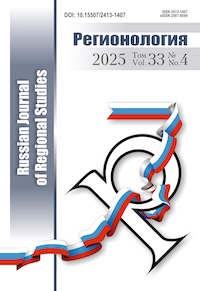O. B. Yarosh, E. A. Mitina. Studying the Range of Organic Products and Their Distribution Channels in the Republic of Crimea
O. B. Yarosh, E. A. Mitina. Studying the Range of Organic Products and Their Distribution Channels in the Republic of Crimea
Acknowledgements: acknowledgments: the research was implemented with the support of the Russian Foundation for Basic Research, grant No. 17-32-00009 ‘Market of Organic Agricultural Products: Formation of Commodity Circulation and Forecasting the State of the Market in a Region.’
Key words: region; channels of distribution; range of products; organic products; food and non-food product groups
Introduction: in the current context of economic activity, studying the distribution channels of organic products in retail chains is of particular interest. In Russia, the issues of development of the organic products market have recently become topical. This is due to a number of objective reasons, including both the considerable momentum of its growth and good prospects for producers and marketers in terms of promoting these products to the markets of Russia’s regions.
Materials and Methods: food and non-food product groups were studied including 137 items of food products divided into 8 product groups and 27 items of non-food products divided into 4 product groups according to the existing commodity classification. Data processing was carried out by means of Statistics and SPSS software. A number of experimental results have been obtained with the use of methods of economic-mathematical modeling.
Results: the range of food and non-food products sold in the trading networks of the region was examined in terms of their compliance with the standards of environmental certification. The correlation between certified organic products and pseudo-organic products (greenwashing) was considered, the share of foreign and domestic organic products was estimated, the main countries producing certified organic products represented on the regional market were identified, and types of markings were analyzed. A classification tree was built, which distributes food products through sales channels; the range of prices for different commodity groups was investigated. The key markers and characteristics of fraud products sold with organic labels were identified.
Discussion and Conclusions: on the basis of the conducted analysis, it was shown that the share of certified organic products in commercial networks and organic shops in the Republic of Crimea and the federal city of Sevastopol accounted for 45.1 %, forgery or ‘pseudo-organic’ products account for 54.9 %. A statistical study of prices and pricing mechanisms for environmentally friendly products in retail chains revealed dependence showing that organic and pseudo-organic products are on average more expensive than usual ones by 30.0 %, which creates an enormous scope for unfair marketing.
REFERENCES
1. Golub N.Ya. [Problems of Organization of Production and Sales of Fruits and Berries]. Sadovodstvo i vinogradarstvo = Horticulture and Viticulture. 1995; 4:2—3. Available at: www.edu.ru/science/sad/d307_09_01/files/golub-pdf (accessed 13.06.2017). (In Russ.)
2. Rushitskaya O.A. [Some Issues of the Distribution of Organic Food Products in the Marketing System]. Agroprodovol’stvennaja politika Rossii = Agro-food Policy in Russia. 2016; 7:90—96. Available at: https://cloud.mail.ru/public/CBCf/Qd6yJ6PVE (accessed 13.06.2017). (In Russ.)
3. Kutarenko N.Ya. [Organic Products Distribution Channels // Goods and Markets]. Tovary i rynki = Goods and Markets. 2014; 1:26—36. Available at: http://econom.chnu.edu.ua/wp-content/uploads/2016/11/kutarenko-8.pdf (accessed 13.06.2017). (In Russ.)
4. Kozlov O.A. [Marketing Analysis of Development of the World Market of Organic Products]. Vestnik Altajskogo gosudarstvennogo agrarnogo universiteta = Bulletin of the Altay State Agrarian University. 2011; 5:117—121. Available at: https://cyberleninka.ru/article/n/marketingovyy-analiz-razvitiya-mirovog... (accessed 13.06.2017). (In Russ.)
5. Mitina E.A. [Formation of Demand for Organic Production]. Marketing v Rossii i za rubezhom = Marketing in Russia and Abroad. 2016; 4:130—134.Available at: https://elibrary.ru/item.asp?id=26587657 (accessed 13.06.2017). (In Russ.)
6. Padel S., Midmore P. The Development of the European Market for Organic Products: Insights from a Delphi Study. British Food Journal. 2005; 8(107):626—647.
7. Ozguven N. Organic foods motivations factors for consumers. Procedia — Social and Behavioral Sciences. 2012; 62:661—665.
Contribution of the authors:
Olga B. Yarosh — initiation of the study, determination of the theoretical and methodological foundations of the research, writing the article.
Ella A. Mitina — search for analytical materials, drawing conclusions, writing and revision of the article.
About the authors:
Olga B. Yarosh, Doctor of Economic Sciences, Professor at the Department of Marketing, Commercial and Customs Matters, Institute of Economics and Administration, V.I. Vernadsky Crimean Federal University (21/4 Sevastopolskaya St., Simferopol, 295015, Russia) (e-mail: yarosh.tnu@gmail.com). ORCID: http://orcid.org/0000-0002-1288-4582. Researcher ID: A-9439-2017.
Ella A. Mitina, Assistant Lecturer at the Department of Marketing, Commercial and Customs Matters, Institute of Economics and Administration, V.I. Vernadsky Crimean Federal University (21/4 Sevastopolskaya St., Simferopol, 295015, Russia) (e-mail: zhilina_ella@list.ru).
For citation: Yarosh O.B., Mitina E.A. Studying the Range of Organic Products and their Distribution Channels in the Republic of Crimea. REGIONOLOGIYA = REGIONOLOGY. 2018; 1(26):90—107. DOI: 10.15507/2413-1407.102.026.201801.90-107

All the materials of the "REGIONOLOGY" journal are available under Creative Commons «Attribution» 4.0
















